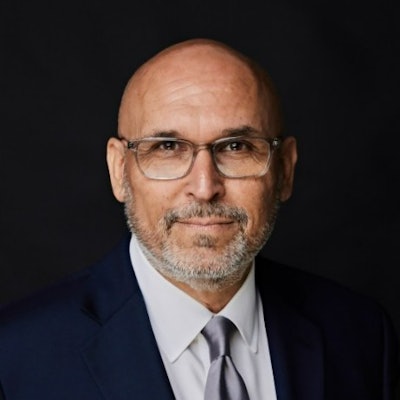After nearly 50 years of funding community colleges based on enrollment and outreach, the state of Texas is considering making the switch to outcome-based funding, rooted in metrics like retention, completion, and the successful transfer to four-year programs.
“The current model is one that’s based upon contact hours, heavily influenced by enrollment and type of courses offered,” says Ray Martinez III, president and CEO of the Texas Association of Community Colleges (TACC).
 Ray Martinez III
Ray Martinez III
The Texas legislature will meet in January, and it will decide if and how the funding model will change by May 2023.
Texas’s 50 community colleges range from rural to urban and receive roughly 24% of their operational budget from state funding. Like the majority of community colleges in the U.S., the pandemic had severe consequences on enrollment across the state. Between fall 2019 and fall 2021, Texas community colleges lost 11% of their enrollment, according to the Texas Higher Education Coordinating Board, which oversees higher education in the state. Yet, the 2020 census revealed Texas to be one of the fastest growing states in the nation. An additional four million residents arrived between 2010 and 2020, mostly in communities of color.
“The population growth in Texas was in urban and suburban areas,” notes Martinez. “There are 254 counties in Texas. One-hundred and forty of our counties lost population. That doesn’t mean we ought to close up shop in those areas; it’s the opposite.”
Workforce needs are also changing in the state, as more jobs are predicted to require some credential or degree. The Texas Higher Education Coordinating Board set a strategic goal in 2015, to be met within 15 years. The plan, Talent Strong Texas, aims for 60% of Texas’s adult population to have or receive some kind of postsecondary credential or degree. The goal is seen as a way to boost the state’s larger and local economies. Just over 40% of Texas’s adult population holds a degree or credential.
“Ensuring access to all student populations across the state will always remain a focus,” Martinez says. “Texas has opened doors to wider and more diverse populations over the last 15 years. We have work to do, but we’re making good steady progress. So, the focus ought to become, ‘what about success?’”
The Texas state budget is set every two years. In 2021, former Texas Representative and now Senator Larry Taylor, a Republican, filed Senate Bill 1230 to create the 12-member Texas Commission on Community Colleges to explore the funding model’s impact across the state and decide if changes should be made. The committee worked through November 2022, holding internal and external meetings to create recommendations to adjust the funding model, which has not been revisited in Texas since the 1970s.
“It is absolutely time for us to be doing this,” says Martinez. “We need people to put resources into these outstanding community colleges that offer affordable, high-quality academic degree programs in those small communities. It matters for the future of this great state.”
Martinez explains that TACC has been involved with the commission since day one, gathering input from community college leaders and presidents, affinity groups, financial aid officers and more. The commission’s first recommendation makes funding dependent on performance and outcomes driven by the production of credentials of value, credentials in critical fields, transfer to four-year institutions, and dual credit (known outside the state as dual enrollment). Defining those terms will likely begin broadly, Martinez says.
Texas wouldn’t be the first state to make the switch to outcome-based funding. Tennessee funds its two- and four-year public institutions based on outcomes. Dr. Russ Deaton, executive vice chancellor for policy and strategy at the Tennessee Board of Regents, helped in the development of Tennessee’s outcome-based funding model back in 2009 when the idea was first introduced. Deaton says the outcome-based funding model has been a boon to his state’s public institutions.
“We built the outcomes funding prototype and pitched it to political leadership,” says Deaton. “It was intrinsically attractive, and then became law. The idea was very attractive to lots of our [college leaders] because they had long felt like the financial policy system had ignored their student success. All it cared about was how many people you enrolled.”
Deaton says the outcome-based funding model has “allowed the state government and its finances to catch up to where our schools already were.”
“They were always focused on graduation and getting students jobs — now the state finances reflects that,” says Deaton. “It’s also allowed our presidents to invest in areas that have demonstrable impact on student outcomes.”
As Texas won’t make its final decision on any funding changes until next year, aspects of the proposed plan may still be changed when the legislative session begins. But Martinez says he is optimistic that the plan will go through. Some sections of the proposal have already gained approval of Texas’s Republican Gov. Greg Abbott.
 Dr. Nikki Edgecombe
Dr. Nikki Edgecombe
“The Texas Higher Education Coordinating Board, which has sponsored the commission, is using its connections to the legislature to ensure that the policy proposals align with the things that legislators are more likely to be able to line up behind,” Edgecombe explains. “There has been an effort to vet how the recommendations develop so they have a stronger chance of success.”
A potential complication of outcome-based funding is that institutions serving low-resourced students could get left behind if their completion numbers lag. The new funding proposal offers financial incentives for schools that serve students from low-income families, low-resourced or academically disadvantaged communities, and non-traditional students. The commission also recommends an increase in financial aid for students with need, and it recommends that students who qualify for free lunches should be able to take dual-credit courses at no cost.
“The devil’s in the details of this,” says Edgecombe. “We’ll have to see. With the legislative process, you never know.”
Dr. Karen A. Stout, president and CEO of Achieving the Dream, a member organization of community colleges working to increase access and equity in postsecondary education, says she is excited to see discussions happening around the potential change whatever the state legislature ultimately decides.
“The fact you can get all these community college presidents to talk about flipping funding toward performance, around agreed upon metrics, and convince a legislature to invest more money, it’s a big win,” says Stout. “It’s strategic. You can only get to that point if you get all your colleges on the same page.”
Stout says the state’s community colleges serve such a vast array of populations and exist in such differing geographic circumstances that coming together is an achievement all its own.
“We all struggle as individual community colleges, as how to demonstrate value to get these new streams of dollars invested in college,” says Stout. “… We need it to reach into the community in new ways. And yes, measure us on how we help students get from point A to point B, and help communities. And you’re seeing [funding] move in that direction.”
This article appeared in the December 8, 2022 edition of Diverse.



















